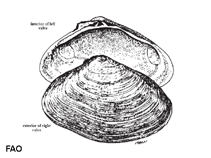Iphigenia brasiliana (Lamarck, 1818)
Giant false donax| Native range | All suitable habitat | Point map | Year 2050 |

|
| This map was computer-generated and has not yet been reviewed. |
| Iphigenia brasiliana AquaMaps Data sources: GBIF OBIS |
Classification / Names Common names | Synonyms | CoL | ITIS | WoRMS
Bivalvia | Cardiida | Donacidae
Environment: milieu / climate zone / depth range / distribution range Ecology
Benthic; depth range 6 - 20 m (Ref. 104365). Tropical
Distribution Countries | FAO areas | Ecosystems | Occurrences | Introductions
Western Atlantic: USA to Brazil.
Length at first maturity / Size / Weight / Age
Maturity: Lm ? range ? - ? cmCommon length : 6.5 cm TL male/unsexed; (Ref. 344)
Short description Morphology
Shell wedge-shaped, heavy, moderately inflated, with rhomboidal outline. Shell surface smooth. Posterodorsal slope somewhat flat. Pallial sinus large. Hinge with 2 lateral teeth (1 bifid) on each valve, lateral teeth absent. Umbones slightly posterior. Periostracum thin, glossy. Colour: tan cream with purple umbonal region; periostracum brown (Ref. 344).
It has a total length of 6.5 cm (Ref. 344). Combination depth range: min from literature, max from estimate.
Life cycle and mating behavior Maturity | Reproduction | Spawning | Eggs | Fecundity | Larvae
Members of the class Bivalvia are mostly gonochoric, some are protandric hermaphrodites. Life cycle: Embryos develop into free-swimming trocophore larvae, succeeded by the bivalve veliger, resembling a miniature clam.
Main reference
References | Coordinator | Collaborators
Leal, J.H. 2003. (Ref. 344)
IUCN Red List Status (Ref. 130435: Version 2024-1)
CITES status (Ref. 108899)
Not Evaluated
CMS (Ref. 116361)
Not Evaluated
Threat to humans
Human uses
Fisheries: commercial
| FishSource |
Tools
More information
Trophic Ecology
Food items
Diet
Food consumption
Ration
Predators
Diet
Food consumption
Ration
Predators
Ecology
Population dynamics
Growth
Age/Size
Length-weight
Length-length
Length-frequencies
Mass conversion
Recruitment
Abundance
Age/Size
Length-weight
Length-length
Length-frequencies
Mass conversion
Recruitment
Abundance
Life cycle
Distribution
Human Related
Aquaculture profile
Stamps, Coins Misc.
Stamps, Coins Misc.
Outreach
References
Internet sources
BHL | BOLD Systems | CISTI | DiscoverLife | FAO(Publication : search) | Fishipedia | GenBank (genome, nucleotide) | GloBI | Gomexsi | Google Books | Google Scholar | Google | PubMed | Tree of Life | Wikipedia (Go, Search) | Zoological Record
Estimates based on models
Price category
(Ref. 80766):
Unknown.



